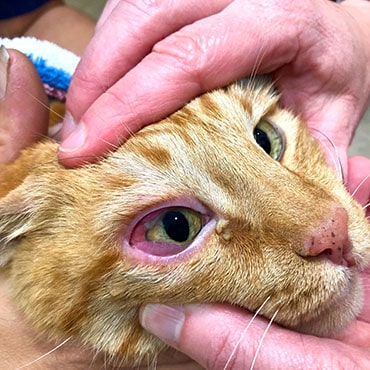Conjunctivitis in cats
Overview
- The conjunctiva is a very thin layer of tissue that covers the inside of the eyelid and runs across the front of the eye.
- It’s so thin, it’s almost invisible.
- Conjunctivitis is when this thin layer of tissue becomes inflamed (swollen), often causing red, itchy, painful and weepy eyes.
- Cat flu is an extremely common cause of conjunctivitis in cats; you can protect your cat from cat flu by making sure their vaccines are up to date.
- Always contact your vet if you notice anything wrong with your cat’s eyes – they are too important to ignore.
- If your cat suffers with conjunctivitis regularly, your vet will investigate why.
Symptoms
Conjunctivitis can affect one or both eyes. Common signs include:
- Pink or red eye(s)
- Weepy eye(s)
- Swollen eyelid(s)
- Blue or cloudy appearance to surface of the eye(s)
- Blinking more than usual
- Closed eye(s)
- Rubbing the eye(s) or face
- Eating less
- Feeling unwell in themselves.

The conjunctiva is almost invisible. It covers the inside of the eyelid and the front of the eye.
When to contact your vet
Always contact your vet if you notice any of the signs above or you have a suspicion there is something wrong with your cat’s eye(s). If conjunctivitis is left too long without treatment it can lead to more serious disease or even loss of an eye.
If your cat suffers with conjunctivitis regularly your vet will check for any conditions that might be causing it.
You know your cat best. If they don’t have the symptoms listed above but you are still concerned it’s always best to contact your vet.
Causes of conjunctivitis in cats
Viruses
- Viruses can cause conjunctivitis, one of the most common being one of the cat flu viruses. Regularly vaccinating your cat is the best way to prevent cat flu.
Bacteria
- There are many different types of bacteria that cause conjunctivitis in cats. It’s likely your cat will pick up bacterial conjunctivitis once or twice in their life.
- Cat flu bacteria “Chlamydophila” can cause conjunctivitis in cats.
Something stuck in the eye
- Something stuck in the eye (i.e. a grass seed or another cat’s claw!).
Eye ulcer (corneal ulcer)
- Eye ulcers are injuries, i.e. scratches or abrasions on the front of the eye.
Irritants
- Your cat is likely to get conjunctivitis if they come into contact with something irritating for example smoke, dust, sand or acid.
Skin allergies (atopy)
- Skin allergies can affect the skin around the eyes. Cats with allergic skin disease suffer with conjunctivitis much more often than cats with healthy skin.
Glaucoma
- Glaucoma is increased pressure in the eye.
Eyelash disorders
- Eyelash disorders such as eyelashes growing from the wrong place or in the wrong direction.
Eyelid disorders
- Eyelid disorders such as eyelids that turn in or are too baggy.
Lumps and swellings in and around the eyes
- Lumps and swellings around the eyes can cause irritation and inflammation.
Treatment
A case of mild conjunctivitis is likely to clear up quickly with a course of treatment from your vet. If your vet suspects there is a condition causing the conjunctivitis (for example skin disease) your cat may need further investigation.
It is likely your vet will recommend some of the following treatments:
Anti-inflammatory, pain relief drugs
- Non-steroidal anti-inflammatory drugs are excellent at reducing pain and inflammation (swelling).
Eye drops
- Lubricating drops (similar to false tears) may be used to keep the eye moist while it heals.
- Antibiotic eye drops fight bacterial infections.
- If your cat is given antibiotic eye drops it’s very important to follow the instructions and complete the course to ensure the infection doesn’t come back.
- Your vet won’t always prescribe antibiotic eye drops for conjunctivitis - only if they think a bacteria is causing the problem. Antibiotics won’t cure other causes of conjunctivitis (viruses for example).
 Video found at youtu.be/_G8qWv4PKss
Video found at youtu.be/_G8qWv4PKss
What if it doesn’t get better?
If your cat isn’t getting better or keeps getting conjunctivitis, they may need some further investigation by your vet. These may include swabs, tear measurement or perhaps referral to a specialist ophthalmologist (eye vet).
Some conditions that cause conjunctivitis need lifelong treatment. If you want to find out more about the conditions that cause conjunctivitis please use the links within the causes section.
Prevention
Some causes of conjunctivitis can be prevented, but not all. Cat flu is a common cause of conjunctivitis, regular vaccination is the best way to prevent it.
Avoid smoking around your pets and avoid using irritating cleaning products or sprays. If you’re not sure if something is safe to use around your cat, ask your vet first. Some bacteria that cause conjunctivitis can be spread between you, your cat and other pets. If your cat is showing symptoms of conjunctivitis keep them away from other pets, don’t put your face next to theirs and be careful to wash your hands after touching their eyes.
Consider insuring your cat as soon as you get them, before any signs of illness start. This will ensure you have all the support you need to care for them.
Published: July 2018
Did you find this page useful?
Tell us more
Please note, our vets and nurses are unable to respond to questions via this form. If you are concerned about your pet’s health, please contact your vet directly.
Thank you for your feedback
Want to hear more about PDSA and get pet care tips from our vet experts?
Sign up to our e-newsletter
Written by vets and vet nurses. This advice is for UK pets only. Illustrations by Samantha Elmhurst.

